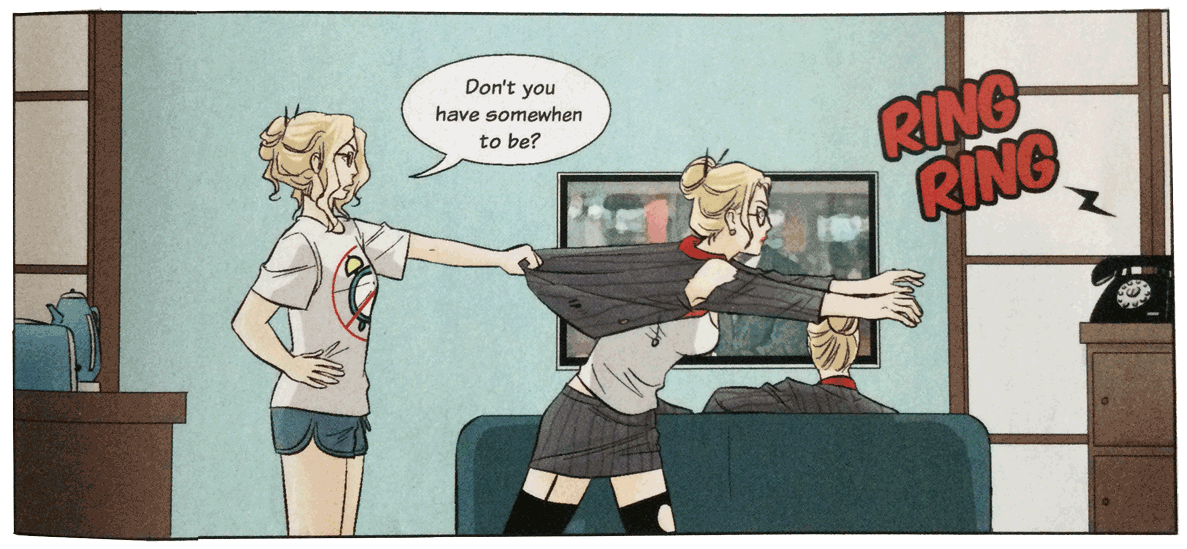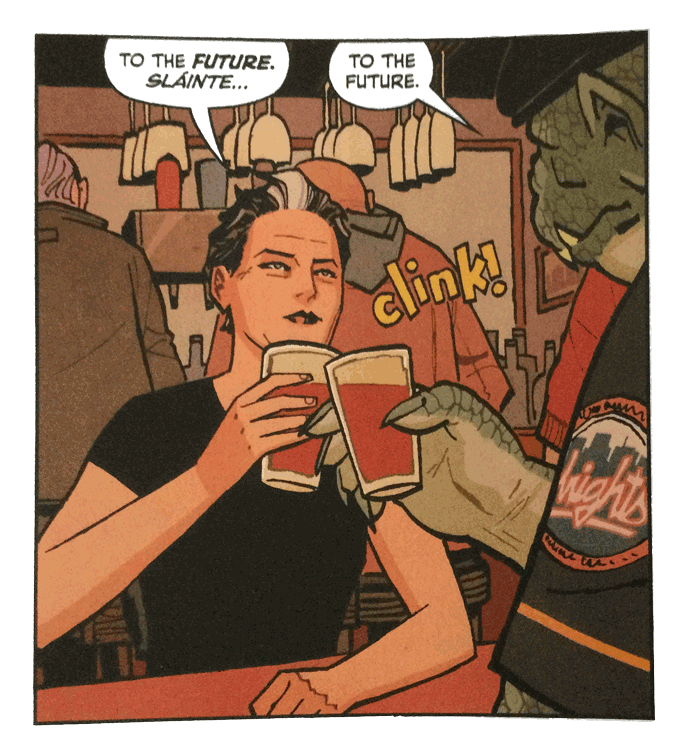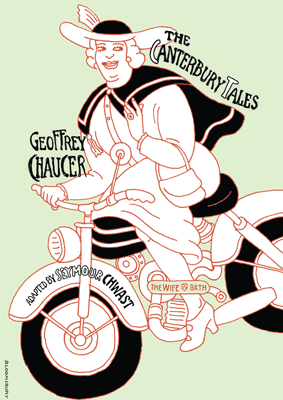

| September 2023 |
|
| Cayti Bourquin and Yishan Li : Paradox Girl | |

What is it? Paradox Girl has one superpower: teleporting anywhere in time or space. She has no super-strength or speed or anything... but she is actually very powerful, because she can keep looping through time, reappearing, and chucking anything at the crisis till it's fixed. There's an amusing bit where she and her partner Axiom Man are fighting a giant monster, and a bunch of Paradox Girls appear trying any old thing: chainsaws, guns, swords, a rocket launcher, a shovel, a whisk.
With this particular great power comes great irresponsibility. Since she can escape almost any situation and go back and try again, she's completely whimsical and never thinks ahead. Her personal life is chaotic (her house is filled with multiple versions of her) and Axiom Man doesn't know what to do with her... but she's too useful to abandon. She also has no real origin any more, because she's rewritten time so many times that she really is a living paradox whose chain of causation has shattered.
This is mostly played for laughs, and it's a really fun idea. Each of the chapters is standalone, and explores her and her powers-- and her limitations-- in some way. Often these repay re-reading, as they're quite closely plotted and you can follow the strands of time and begin to see how they fit together.
A couple of stories attempt to go a little deeper. One is a little too ambitious, I think, and doesn't quite work. But another, when PG is put into a situation where she can't use her powers, is quite successful. I hope Bourquin finds a way to continue the series, or do something else in comics. The art is really well done, though more like Squirrel Girl than Planetary. (Looking at the above example, I'm impressed by the wrinkles. I can’t draw clothing well without a model.)
| Cliff Chiang : Catwoman: Lonely City | |
 Chiang did everything on this 200-page book-- writing, drawing, inking, lettering, coloring; apparently it took years. It's worth it. It's probably the best Catwoman story ever, and one of the best in the Batman mythos.
Chiang did everything on this 200-page book-- writing, drawing, inking, lettering, coloring; apparently it took years. It's worth it. It's probably the best Catwoman story ever, and one of the best in the Batman mythos.
The conceit of the story is simple enough: one terrible night killed off Batman, Nightwing, Commissioner Gordon, and Joker, and put Catwoman in prison. Superheroes have been banned in Gotham City for ten years, and Harvey Dent is the mayor, with fascist "Batcops" to enforce his grim peace. But he's running for reelection against Barbara Gordon, and Catwoman just got out of prison and has some scores to settle.
She's in her fifties now, and so are all the other old heroes and villains, and the book leans hard into questions of middle age, and whether to continue what you've always done or put it to rest, and whether Batman is a lunatic for going out at night to beat up pychos rather than use his vast fortune for good. That's always been a possible question, but it's rare that a DC comic puts it right out there that yeah, it was kinda lunatic.
There's a rule of thumb on whether a Catwoman comic is good: does it center on heists? That's what she's built for, what she's good at, and centering on anything else is usually a bad move. So the good news is that the book features a series of heists, of increasing ambition. This is not at all incompatible with asking whether doing heists is worth doing at her age.
One of the fun things about the book is seeing what has happened to everyone in this post-suits era. Quite a few heroes and villains show up, most of them a little worse for wear... Killer Croc, for instance, has terrible hip pain, and Poison Ivy learned that growing coffee was a far better basis for eco-activism than terrorizing Gotham. The book also features about the most handsome and balanced Riddler you've ever seen.
The overall tone of the book is rueful, but not grim, much less grimdark. There are comic bits, plenty of action adventure, call-outs to classic comics, and some surprising plot twists. I have to praise DC for allowing writers to mess with their material, if only in one-off titles like this, or Arkham games, or the Harley Quinn TV series. The whole 84-year saga is rich but also incoherent and baffling: the best way to shake it up is to allow a single consciousness to re-order it, and draw upon whatever earlier moments and stories they choose.
Chiang can draw as well as write; it's really a beautiful book throughout.
The one thing I'll warn you about is that you may have to read it twice to really get it. The first time you just want to find out what happened. The second time you can figure out what Chiang is doing, trace the character arcs, and admire the gut punches to Frank Miller's nasty-minded Dark Knight.
| Seymour Chwast : The Canterbury Tales | |
 You may not have heard of Chwast, but his pop art style was famous for decades— you saw it in magazine illos, package design, book covers, posters. And it turns out he's been doing comics too.
You may not have heard of Chwast, but his pop art style was famous for decades— you saw it in magazine illos, package design, book covers, posters. And it turns out he's been doing comics too.
This is an adaptation of Geoffrey Chaucer’s The Canterbury Tales. If you fell asleep in English class, this appeared about 1400, and it's a set of stories with a framing device: a group of 30 pilgrims is traveling from London to Canterbury, and tell the stories to each other. The stories are as diverse as the pilgrims: some adventurous, some religious, some satirical, some bawdy. The pilgrims comment on the stories as they're told, and frequently devise stories to demean the profession of other pilgrims.
In a mere 143 pages Chwast retells each of the 24 stories, and the "prologues" as well (i.e. the interactions between the pilgrims and their editorial comments).
On the whole it works quite well. The stories are compressed but don’t feel rushed. It especially suits the satirical and bawdy stories— you really don’t need more than a few pages, for instance, to tell the summoner’s calumny of friars and the friar’s of summoners.
Some stories do suffer, e.g. those told by Chaucher himself (Thopas and Melibee). In the original the story of Sir Thopas is a grandiose parody of fantasy epics, interrupted by the chief pilgrim as boring. There’s no real way to get this across in Chwast’s version, and he barely tries. Melibee, one of the longest Tales, is reduced to a single panel.
The art style is, well, very Seymour Chwast. It’s simple and yet has that postery boldness he’s best known for. It’s black and white, which is almost a pity: the three colors of the cover are a much better look.
The stories themselves are fully medieval, but in the framing device the characters are riding motorcycles instead of horses. This is... an odd decision. I get the playful intention, and maybe motorcycles are more fun to draw, but it certainly doesn’t modernize the stories and indeed undermines the framing device. (The trip is only 54 miles and takes an hour and a half by train or car... the whole idea is that it’s a leisurely trip on horseback, just long enough to tell a bunch of stories.)
I feel I should warn you that some of the stories are not to modern tastes— there's plenty of sex and violence, there’s antisemitism and misogyny. But it’s also a glimpse into the medieval world and its people. And Chaucer himself intended the stories to be contradictory and over-the-top. E.g. though some of the clerics indulge some screeds against women, the Wife of Bath— who has had five husbands and dominated them all— is allowed to refute them both with her story and her own happy life.
I suspect you’ll enjoy it more if you read the Tales at some point; on the other hand, it’s a pretty painless way to be introduced to the original work.
